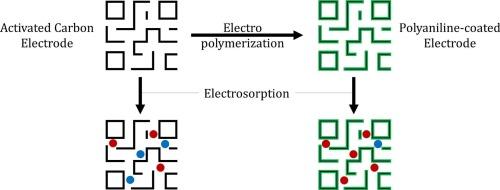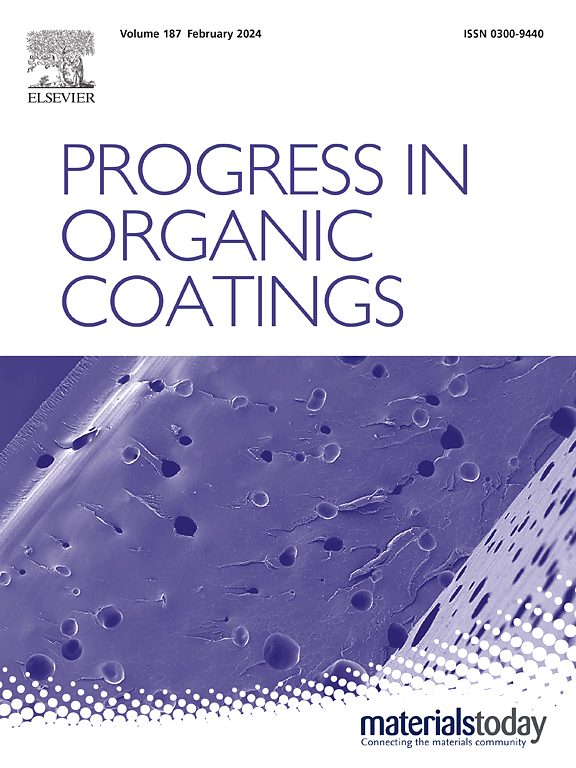Effect of dopants in polyaniline-coated capacitive deionization electrodes on anion selectivity
IF 6.5
2区 材料科学
Q1 CHEMISTRY, APPLIED
引用次数: 0
Abstract
This study explores the viability of employing polyaniline (PAni) coatings doped with different anions in capacitive deionization (CDI) electrodes for ion recovery purposes. Multiple CDI electrodes were fabricated by electrodepositing PAni in the presence of four mineral acids (HCl, HNO3, H2SO4, and H3PO4) to incorporate the corresponding anions into the PAni network. The results highlight the critical role of dopants and polymerization conditions in determining ion adsorption behavior. Notably, the PAni/H2SO4 electrode achieved approximately 20 % reduction in chloride adsorption while maintaining consistent sulfate adsorption compared to the control. The behavior of PAni/HCl, PAni/HNO3, and PAni/H3PO4 systems were not as pronounced compared to the PAni/H2SO4 system, under tested parameters, highlighting the dopant-dependent influence of polymerization conditions. Specifically focusing on the PAni/H2SO4 system, various polymerization conditions were investigated, and their ion adsorption characteristics were evaluated using a CDI system. It was observed that reducing the monomer concentration or the polymerization duration can enhance the selective properties of the coated electrode in this specific scenario. Additionally, distinct differences in polymer morphology based on polymerization conditions and dopants were observed, underlining the need for further research to understand the influence of these variables on the morphology of the PAni network and the resulting ion adsorption behavior of the coatings.

聚苯胺涂层电容式去离子电极中的掺杂剂对阴离子选择性的影响
本研究探讨了在电容式去离子电极(CDI)中使用掺杂不同阴离子的聚苯胺(PAni)涂层进行离子回收的可行性。在四种矿物酸(HCl、HNO3、H2SO4 和 H3PO4)存在的情况下,通过电沉积 PAni 来将相应的阴离子纳入 PAni 网络,从而制造出多种 CDI 电极。结果凸显了掺杂剂和聚合条件在决定离子吸附行为中的关键作用。值得注意的是,与对照组相比,PAni/H2SO4 电极的氯离子吸附量减少了约 20%,而硫酸盐吸附量却保持不变。在测试参数下,PAni/HCl、PAni/HNO3 和 PAni/H3PO4 系统的行为与 PAni/H2SO4 系统相比并不明显,这凸显了聚合条件对掺杂剂的影响。针对 PAni/H2SO4 体系,研究了各种聚合条件,并使用 CDI 系统评估了其离子吸附特性。结果表明,在这种特定情况下,降低单体浓度或缩短聚合时间可以提高涂层电极的选择性。此外,根据聚合条件和掺杂剂的不同,聚合物形态也存在明显差异,这突出表明有必要开展进一步研究,以了解这些变量对 PAni 网络形态以及涂层离子吸附行为的影响。
本文章由计算机程序翻译,如有差异,请以英文原文为准。
求助全文
约1分钟内获得全文
求助全文
来源期刊

Progress in Organic Coatings
工程技术-材料科学:膜
CiteScore
11.40
自引率
15.20%
发文量
577
审稿时长
48 days
期刊介绍:
The aim of this international journal is to analyse and publicise the progress and current state of knowledge in the field of organic coatings and related materials. The Editors and the Editorial Board members will solicit both review and research papers from academic and industrial scientists who are actively engaged in research and development or, in the case of review papers, have extensive experience in the subject to be reviewed. Unsolicited manuscripts will be accepted if they meet the journal''s requirements. The journal publishes papers dealing with such subjects as:
• Chemical, physical and technological properties of organic coatings and related materials
• Problems and methods of preparation, manufacture and application of these materials
• Performance, testing and analysis.
 求助内容:
求助内容: 应助结果提醒方式:
应助结果提醒方式:


